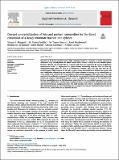Por favor, use este identificador para citar o enlazar a este item:
http://hdl.handle.net/10261/202487COMPARTIR / EXPORTAR:
 SHARE SHARE
 CORE
BASE CORE
BASE
|
|
| Visualizar otros formatos: MARC | Dublin Core | RDF | ORE | MODS | METS | DIDL | DATACITE | |

| Título: | One-pot co-crystallization of beta and pentasil nanozeolites for the direct conversion of a heavy reformate fraction into xylenes |
Autor: | Margarit, V.J.; Portilla, M.T.; Navarro, María Teresa; Abudawoud, R.; Al-Zahrani, I.M.; Shaikh, S.; Martínez Sánchez, Cristina CSIC ORCID; Corma, Avelino CSIC ORCID | Fecha de publicación: | 5-jul-2019 | Editor: | Elsevier BV | Citación: | Applied Catalysis A: General 581: 11-22 (2019) | Resumen: | Upgrading of the heavy reformate fraction (HR), containing mainly C aromatics, is usually performed by dealkylation or by transalkylation with added benzene and/or toluene to obtain the more valuable xylenes. However, when the costs related to the use of benzene and toluene are considered, the one-step dealkylation/transalkylation of the C alkylaromatics to xylenes becomes economically attractive. Thus, in a first step, ethylmethylbenzenes (EMB) will have to be dealkylated to toluene, which will then react with the trimethylbenzenes (TMB) present in the HR feed to produce xylenes by transalkylation. Medium pore zeolites will favor dealkylation, whereas large pore zeolites will be more adequate for carrying out the transalkylation reaction. In this work, we present the one-pot synthesis of beta-pentasil aggregates with tunable ratios of the large pore beta to the medium pore component. We show that the close proximity of the beta and pentasil nanocrystals obtained by one-pot co-crystallization synthesis, results in a highly efficient catalyst for the consecutive dealkylation/transalkylation process. The bifunctional catalyst based on the co-crystallized aggregate is more active and selective to xylenes than a catalyst based on a physical mixture of equivalent beta and pentasil nanozeolites synthesized following an analogous procedure. The small crystallite sizes of the co-crystallized zeolites provide the additional advantage of a lower deactivation rate as compared to a reference benchmark catalyst. Results are shown on both, model molecules and industrial HR feed. | Versión del editor: | http://dx.doi.org/10.1016/j.apcata.2019.05.014 | URI: | http://hdl.handle.net/10261/202487 | DOI: | 10.1016/j.apcata.2019.05.014 | Identificadores: | doi: 10.1016/j.apcata.2019.05.014 issn: 0926-860X |
| Aparece en las colecciones: | (ITQ) Artículos |
Ficheros en este ítem:
| Fichero | Descripción | Tamaño | Formato | |
|---|---|---|---|---|
| One-Pot co-crystalization 1-s2.0-S0926860X19302182-main.pdf | 6,58 MB | Adobe PDF |  Visualizar/Abrir |
CORE Recommender
SCOPUSTM
Citations
11
checked on 25-may-2024
WEB OF SCIENCETM
Citations
9
checked on 24-feb-2024
Page view(s)
169
checked on 27-may-2024
Download(s)
207
checked on 27-may-2024
Google ScholarTM
Check
Altmetric
Altmetric
Este item está licenciado bajo una Licencia Creative Commons

